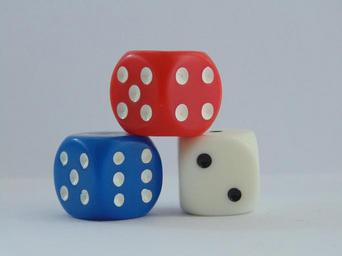When we try to solve the probability of compound events examples.
We are aiming to work out the probability of 2 events occurring, instead of just 1 event.
These 2 events can be either “mutually exclusive”, or “mutually inclusive”.
Mutually Exclusive Events
When events as classed as ‘mutually exclusive’, they are events that can’t occur at the same time.
For example if you were flipping a coin you can get either a “Head” or a “Tails”, you can’t get both a Head and a Tail on one flip of a coin.
A Head and a Tail occurring on a coin flip are mutually exclusive events.
P( A or B ) = P( A ) + P( B)
Examples
(1.1)
On rolling of a fair dice, what is the probability of rolling a 1 or a 4?

Solution
P( 1 ) = \bf{\frac{1}{6}} , P( 4 ) = \bf{\frac{1}{6}}
P( 1 or 4 ) = \bf{\frac{1}{6}} + \bf{\frac{1}{6}} = \bf{\frac{2}{6}} = \bf{\frac{1}{3}}
The probability of landing either a 1 or a 4 on one dice roll is \bf{\frac{1}{3}}.
(1.2)
A bag of golf balls has 14 balls inside numbered from 1 to 14.
What is the probability of randomly selecting a golf ball from the bag that has a number less than 5 or higher than 11?
Solution
P( less than 5 ) = \bf{\frac{4}{14}}
P( higher than 11 ) = \bf{\frac{3}{14}}
P( less than 5 or higher than 11) = \bf{\frac{4}{14}} + \bf{\frac{3}{14}} = \bf{\frac{7}{14}} = \bf{\frac{1}{2}}
The probability of picking out a golf ball which is numbered either less than 5 or higher than 11 is \bf{\frac{1}{2}}.
Probability of Compound Events Examples,
Mutually Inclusive Events
With probability of compound events examples, “mutually inclusive events” are events that can occur at the same time as each other.
If we recall the bag of numbered golf balls from example (1.2) above again.
We can consider the probability of picking out a ball numbered less than 8, or a ball specifically numbered 4.
These events could both occur at the same time, as a golf ball numbered 4, is also a golf ball that is numbered less than 8.
They are mutually inclusive events.
Establishing the probability of compound events cases such as this, involves the formula from before seen above, but with a slight alteration.
Golf ball either numbered 4 or less than 8:
For the probability of picking out a golf ball that is either a number 4 or a number less than an 8.
P( 4 ) = \bf{\frac{1}{14}} , P( less than 8 ) = \bf{\frac{7}{14}}
P( 4 AND less than 8 ) = P( 4 ) × P( 4 | less than 8 ) = \bf{\frac{1}{14}} × 1 = \bf{\frac{1}{14}}
Now to work out the probability of picking out a golf ball that is either a 4 or less than an 8?
P( 4 or less than 8 ) = P( 4 ) + P( less than 8 ) − P( 4 AND less than 8 )
=> P( 4 or less than 7 ) = \bf{\frac{1}{14}} + \bf{\frac{7}{14}} − \bf{\frac{1}{14}} = \bf{\frac{7}{14}} = \bf{\frac{1}{2}}
Example
(2.1)
With a deck of 52 playing cards, what is the probability of picking out at random either a SPADE or an ACE card?
Solution
P( SPADE or ACE ) = P( SPADE ) + P( ACE ) − P( SPADE and ACE )
P( SPADE ) = \bf{\frac{13}{52}} , P( ACE ) = \bf{\frac{4}{52}} = \bf{\frac{1}{13}}
P( SPADE | ACE ) = \bf{\frac{1}{4}}
P( SPADE and ACE ) = P( ACE ) × P( SPADE | ACE ) = \bf{\frac{1}{13}} × \bf{\frac{1}{4}} = \bf{\frac{1}{52}}
P( SPADE or ACE ) = \bf{\frac{13}{52}} + \bf{\frac{4}{52}} − \bf{\frac{1}{52}} = \bf{\frac{16}{52}}
The probability of picking out at random a SPADE card or an ACE card is {\frac{16}{52}}.
- Home ›
- Probability and Statistics › Compound Events Probability